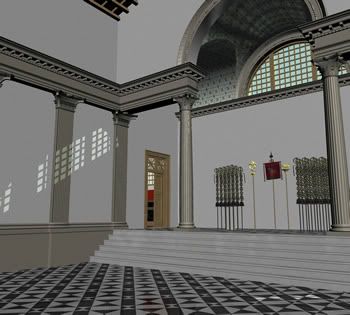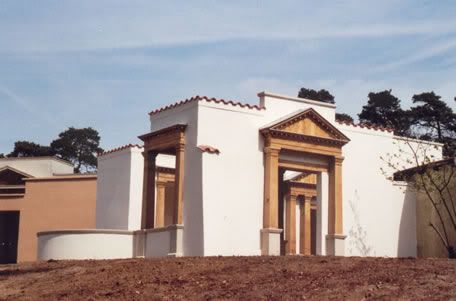A company called PANSA BV, based in the Netherlands, specializes in the reconstruction of buildings from imperial Rome, based on archeology and knowledge of the Romans' design and construction methods.
Most of their revivals have not actually been built in present times. They are CAD simulations, but apparently the specifications are detailed enough that they could actually be the basis for full-size, three-dimensional structures. Their site says:
Reconstructions by PANSA BV incorporate in-depth analysis of the archaeological evidence, including the architectural ornaments and the remains of floor and wall decorations. The reconstructions are worked out into architectural and structural detail according to Roman building and construction techniques. Our combined archaeological and architectural approach allows for life-sized reconstruction.

The only real-life construction project based on PANSA's work seems to be the "Roman Cardo" in the Biblical Open-Air Museum. (The cardo was a main street in Roman towns and military camps, lined with shops and other features of economic life. Yes, I had to look it up.)

Cardo, Biblical Open-Air Museum

Cardo, Biblical Open-Air Museum
Ancient Roman architecture often gets knocked, except for its astonishing engineering aspects. Most of its ideas, other than the dome, were supposedly "borrowed" from the Greeks, who allegedly did the real cerebrum work and had an inspiration account with their gods. The Romans just went for overpowering stuff like gargantuan civic bathhouses, or decadent seaside villas of the rich, so it's said.
But we can't justly compare Greek and Roman. Practically everything from ancient Greece is in ruins, and we don't even have contemporary paintings of what their buildings looked like. By now everyone knows that the austere white marble of Greek temples was tarted up in flashy colors — probably impressive, but not the serene, platonic forms most of us still envision. We don't know what their non-sacred edifices were like. They may have been mean and drab, the antique equivalent of post offices.
Thanks to Mount Vesuvius and archeology, plus the Roman world being centuries closer to us in time, we can better judge their buildings. A few, like the Pantheon, are virtually intact. We know how their villas were designed and decorated.

"The so-called aedes in the headquarters of the
Hunerberg legionary fortress in Nijmegen."
But we can't justly compare Greek and Roman. Practically everything from ancient Greece is in ruins, and we don't even have contemporary paintings of what their buildings looked like. By now everyone knows that the austere white marble of Greek temples was tarted up in flashy colors — probably impressive, but not the serene, platonic forms most of us still envision. We don't know what their non-sacred edifices were like. They may have been mean and drab, the antique equivalent of post offices.
Thanks to Mount Vesuvius and archeology, plus the Roman world being centuries closer to us in time, we can better judge their buildings. A few, like the Pantheon, are virtually intact. We know how their villas were designed and decorated.

"The so-called aedes in the headquarters of the
Hunerberg legionary fortress in Nijmegen."
The Roman Empire was unquestionably fiercely militaristic and ruthless toward its, or its rulers', enemies, foreign and domestic. (Those philosophy-loving, democratic Greeks were a militaristic and ruthless lot too, as Herodotus makes clear.) But I see no evidence that Roman architecture was brutal. What I have observed of it in person strikes me as pleasing and well proportioned. The wall frescos from their houses that have been preserved aren't all pornography and gladiatorial fights; charming scenes of gardens and mysteriously dreamy landscapes have been found in great numbers, and were probably more the norm.

From the Roman Cardo, Biblical Open-Air Museum

From the Roman Cardo, Biblical Open-Air Museum
In the late 19th century, Roman architecture enjoyed a brief revival, culminating in New York's original Pennsylvania Station, torn down in the '60s in the United States's worst act of cultural vandalism. (I am lucky enough to have visited it and remember it.) That was before architects became egotists, outdoing each other in originality that as often as not inflicts long-standing eyesores on the public.
We could do worse than promote a second Roman revival. We already have done worse.
We could do worse than promote a second Roman revival. We already have done worse.



2 comments:
Very interesting, Rick. Thanks for posting that. Maybe if our civilization ever starts ascending again, those buildings will be popular.
Beautiful!
But one thing's missing: trees and plants and flowers. The Romans had a lot of those.
Post a Comment